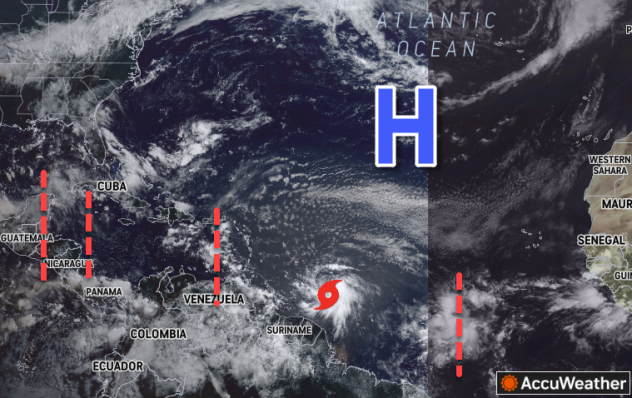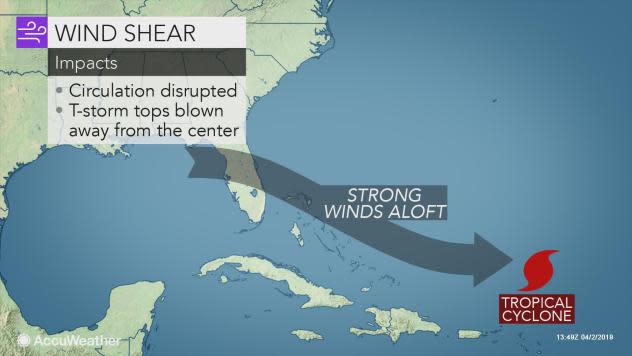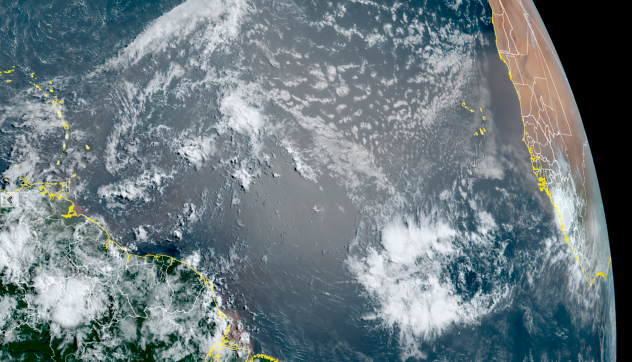Heard of a tropical wave? Here's what you need to know
The term "tropical wave" is one that comes up time and time again during the Atlantic and Pacific hurricane seasons. Tropical waves happen most often over the ocean, but the term "wave" is atmospheric in nature and does not refer to undulations occurring in the ocean water.
According to AccuWeather Senior Meteorologist Dan Kottlowski, 85% of all tropical storm development can trace its origins to tropical waves. AccuWeather meteorologists are constantly monitoring tropical waves that emerge off the coast of Africa during hurricane season. So, what exactly is a tropical wave?
A tropical wave is an area of low pressure in the atmosphere, typically situated north to south, moving westward from Africa into the Atlantic. They are usually represented on weather maps with a straight or dashed brown or red line.
 |
Tropical waves (red dashed lines), annotated on a satellite image July 21, 2021. (AccuWeather) |
Whether or not these waves flourish and develop into tropical storms depends on the conditions in front of them and where they exit the African coast.
Where do tropical waves originate?
Tropical waves typically begin their journeys across the Atlantic Ocean in Africa, tracking from east to west across the continent, but their origins can be even farther away.
"In most cases, these disturbances have their origins from upper-level disturbances rotating around the outer periphery of the Indian Monsoon high pressure area, which is typically located just northwest of the Indian sub-continent," Kottlowski said.
How do tropical waves maintain strength?
Strong winds aloft can disrupt tropical wave and cyclone development, a force known as "wind shear."
Tropical waves thrive on conditions with low wind shear, warm waters and moist, unstable air. Often, conditions aren't ripe for development early in hurricane season, and obstacles to storm development can remain throughout the year.
 |
"During May and June and into July, cooler SSTs [sea surface temperatures] along with dry, stable air and lingering vertical wind shear prevent tropical development from occurring in the far east Atlantic," Kottlowski said.
Conditions early in the season are generally unfavorable north of 10 degrees North latitude. Systems that stay farther south, closer to warmer waters near the equator, have a stronger chance of developing early in the season.
CLICK HERE FOR THE FREE ACCUWEATHER APP
However, storms emerging off the coast of Africa must also find the right balance between being too far north and too close to the equator. Storms too close to the equator experience less of the Coriolis effect, which helps storms rotate.
"As a system gains latitude it gains Coriolis parameter supporting a more favorable environment to wrap up," Kottlowski said. "This is why as developing tropical systems gain latitude they intensify."
If a tropical wave survives its journey westward, it will find increasingly warm waters and moist air as it approaches the Lesser Antilles, a group of islands in the Caribbean Sea comprising parts of the Leeward Islands and Windward Islands. Still, tropical systems must battle wind shear and occasional outbreaks of Saharan dust, which inhibits tropical growth.
 |
A cloud of Saharan dust as seen in a satellite image. Saharan dust limits tropical development in the Atlantic basin. (CIRA / RAMMB) |
"Shear tends to be less frequent during the heart of the hurricane season and especially from late August through mid-September," Kottlowski said.
Tropical waves can also reach the Pacific Ocean, triggering the development of tropical disturbances many thousands of miles away from their point of origin.
What else is there to know about tropical waves?
 |
Hurricane Dorian (2019), which hit a maximum sustained wind speed of 185 mph as it passed over the Bahamas, was a Cape Verde hurricane. |
The number of tropical waves emerging from the African coastline tends to intensify as the summer progresses and hurricane season reaches its September peak.
Waves that pass near and south of the Cape Verde islands off the coast of Africa and develop into hurricanes before reaching the Caribbean are often referred to as Cape Verde hurricanes. Cape Verde storms account for many long-lasting and damaging hurricanes, including Hurricane Laura (2020), Hurricane Dorian (2019) and Hurricane Ivan (2004).
Keep checking back on AccuWeather.com and stay tuned to the AccuWeather Network on DirecTV, Frontier, Spectrum, FuboTV, Philo, and Verizon Fios.

 generic
generic 









